- DNS Records
- DNS Query Solving Mock Example
- DNS Query and Reply Protocol
- DNS Caching
- DNS Record Insertion
- DNS Attack
- Summary
- Appendix
50.005 Computer System Engineering
Information Systems Technology and Design
Singapore University of Technology and Design
Natalie Agus (Summer 2025)
DNS Records and Protocol
Detailed Learning Objectives
- Interpret DNS Records
- Identify different types of DNS records: A, MX, NS, CNAME, and SOA.
- Explain the purpose and structure of each DNS record type.
- Recognize the data fields in a DNS resource record (name, value, type, TTL).
- Analyze DNS Query Process using DNS Queries Tools
- Explain how DNS queries are resolved, including the roles of local and authoritative nameservers.
- Explain iterative and recursive DNS queries using tools like
digandnslookupto query DNS records.- Interpret the results provided by these tools, including understanding query flags and responses.
- Explain the process of resolving CNAME records to their canonical names.
- Explain DNS Caching Mechanism
- Explain how DNS caching works and its importance in speeding up DNS resolution.
- Question how TTL (Time to Live) impacts DNS caching and record updates.
- Analyze the performance impact of DNS caching by observing query response times.
- Explain the Procedure for DNS Record Insertion and Management
- Explain the steps involved in registering a domain and setting up DNS records.
- Identify the roles of DNS registrars and authoritative nameservers.
- Explain the process of updating TLD (Top-Level Domain) records with NS records.
- Report DNS Attacks and Mitigations
- Identify common types of DNS attacks, such as DDoS, DNS cache poisoning, and DNS amplification attacks.
- Appreciate the impact of these attacks on DNS infrastructure.
- Discuss strategies to mitigate these DNS attacks.
These learning objectives aim to provide a comprehensive understanding of DNS records, query processes, tools, caching mechanisms, record management, and security aspects of DNS.
DNS Records
In this section we are going to analyse how some types of DNS records that are stored in DNS servers look like, in particular, these record types: A, MX, and NS.
Resource Records
DNS resource records (RR) are entries stored in a DNS zone file that provide information about a domain. These records are used to facilitate the translation of human-readable domain names into IP addresses (which are necessary for locating and identifying computer services and devices on the Internet) and to provide other essential information associated with the domain.
In short, the DNS is basically a distributed database storing these RRs.
The data structure of a resource record is as follows. Each time a client query for hostname resolution, the servers consults these records.

An RR in general contains the following information (but not limited to): name, value, type, and TTL. The table below explains what each information means:
| Name | Value | Type | TTL |
|---|---|---|---|
| Hostname, e.g: sutd.edu.sg | IP Address | A | N seconds |
| Domain, e.g: sutd.edu.sg | The nameserver that is authoritative to this domain | NS | N seconds |
| Alias name for some canonical (real) hostname | Real hostname | CNAME | N seconds |
| Domain, e.g: sutd.edu.sg | mailserver name, e.g: sutd-edu-sg.mail.protection.outlook.com. | MX | N seconds |
Note that sutd.edu.sg are both domain and hostname. However this is just a specific example. Not all domains are hostnames, and not all hostnames are domains. See this appendix section to understand more.
Types:
- A: Address, it contains the IPv4 address of the hostname in question. You might sometimes see type AAAA which value contains IPv6 instead of IPv4.
- NS: Name Server, it tells which nameservers are authoritative for a that domain in question. You can have multiple NS records for load distribution (increasing availability)
- CNAME: Canonical Name, maps an alias name to a true or canonical domain name. Requires more probing (queries) to resolve to an IP eventually. It is like the same website with two or more URLs.
- MX: Mail server, points you to the mail server name responsible for the domain in question.
Notice that out of all the 4 types that we learn, only the A record has an IP address in its “value” field.
CNAME Record
The CNAME records allow for many-to-one mapping, where multiple domain name points to the same canonical name. For instance, www.twitch.tv and player.twitch.tv both point to twitch.map.fastly.net.
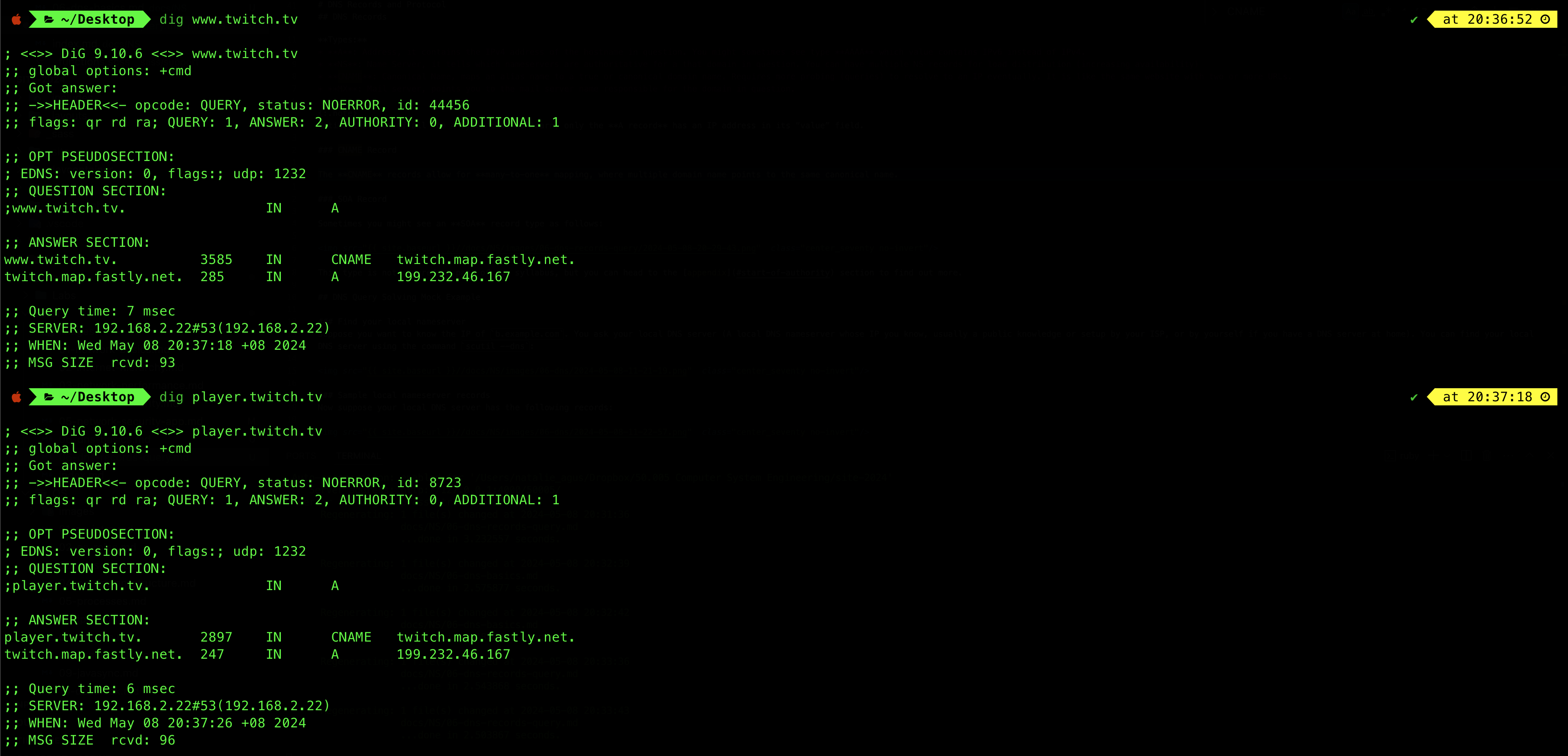
SOA Record
Sometimes you might see an SOA record type as follows:
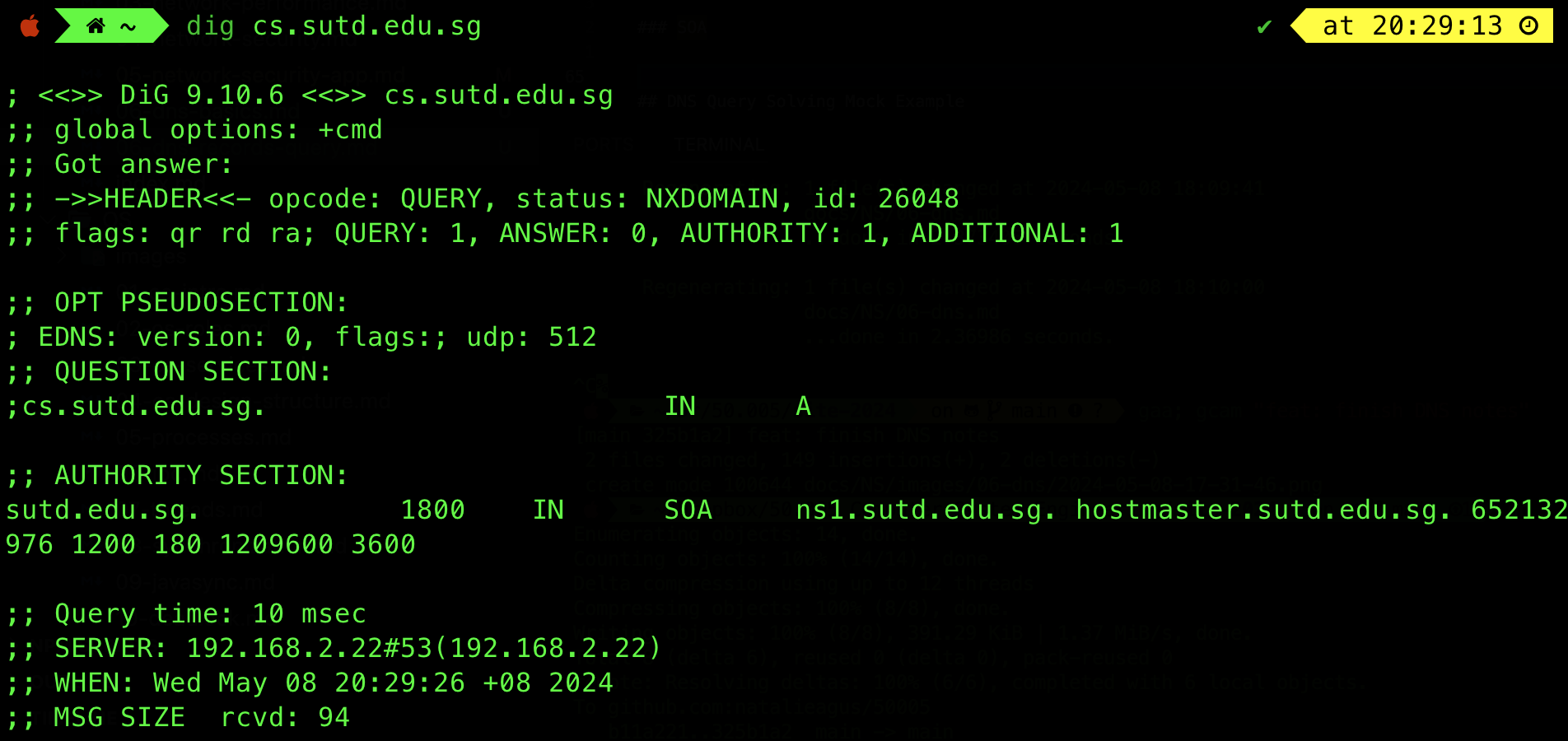
This type is not covered as part of our syllabus, but you can head to the appendix section to find out more.
DNS Query Solving Mock Example
Find your local nameserver
Suppose you want to know the IP of b.example.com. You ask your local DNS server (A local DNS nameserver whose IP you know, usually a public knowledge or setup by your ISP, or by yourself if you have a DNS server at home). You can find your local DNS server using the command scutil --dns:

Sample local nameserver records
Now suppose your local DNS server has the following records:

This means that your local DNS server does not know what b.example.com’s IP address is, since it contains only its NS record. We should then ask NS2.server.com regarding b.example.com’s IP address.
Since b.example.com NS record points to NS2.server.com, it means that NS2.server.com is the authoritative nameserver for b.example.com.
Further probe to b.example.com authoritative nameserver
The local DNS server can then do the job of translating NS2.server.com into its IP address: 111.222.125.124 since it already has the A record of NS2.server.com. Otherwise, we have to find the IP for NS2.server.com first by querying either the root server or the .com TLD server.
Afterwhich, we (or the local DNS server, depending on whether the query is iterative or recurisve) shall ask 111.222.125.124 (NS2.server.com) if it has the A record of b.example.com.
Sample authoritative nameserver records
Now suppose NS2.server.com has the following record:

The first query to NS2.server.com will show that b.example.com is a CNAME record, so it is simply an alias of another hostname called a.example.com.
Resolving b.example.com
The local DNS server or the NS server (depending on whether it is an iterative or recursive query) has to continue the probe and send another DNS query to resolve the IP address for a.example.com, and finally NS2.server.com returns a.example.com’s A record with IP of 10.12.14.145.
Now that hostname-IP translation for b.example.com is resolved, we can start sending requests to 10.12.14.145 (our intended b.example.com host).
DNS Query and Reply Protocol
DNS queries and replies follow a specific message format outlined in RFC 1035, which structures the data to be transmitted over the network.
The format is as follows. Below we explain certain parts of the message:
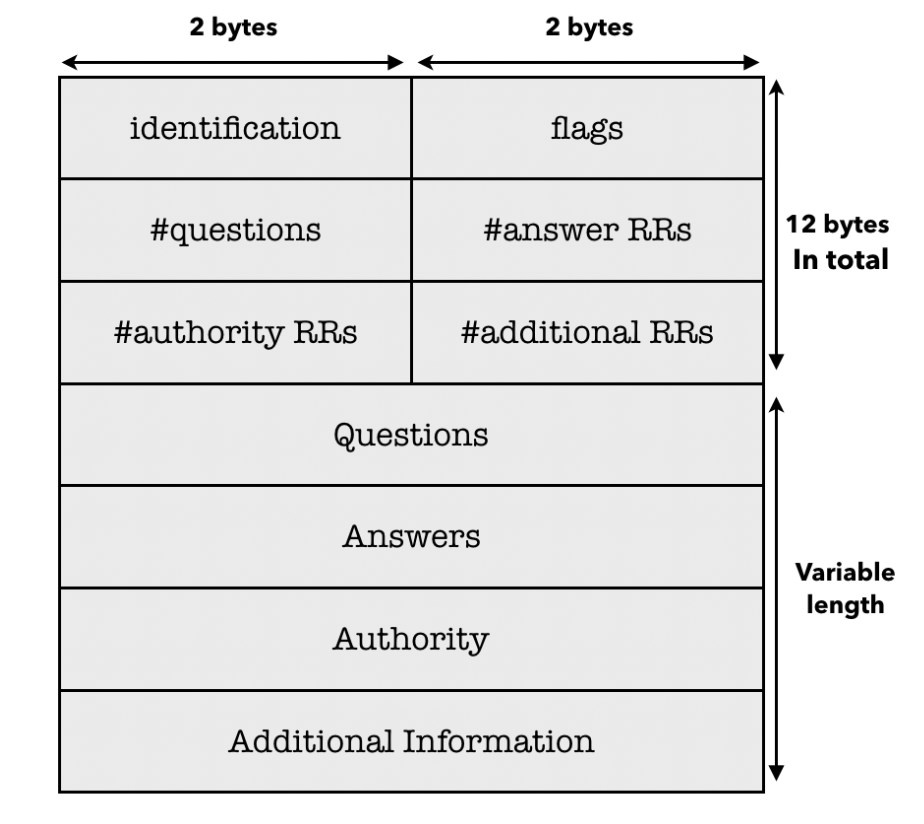
Identification: 16 bit number for query, reply uses the same number
Flags:
- Query or Reply?
- Recursion desired or available?
- Reply is authoritative?
Size: Varies, depending on number of RRs in each section. Generally, replies are larger than queries.
Components of the variable lengths of DNS query / reply:
- Questions: name, type fields for a query
- Answers: RRs in response to the query
- Authority: Records for authoritative servers
- Additional information: possibly helpful information
Tools like dig and nslookup are designed to craft DNS query messages and query DNS servers, then render out the information contained in DNS reply messages. They provide different levels of detail and formats, helping users and administrators understand DNS responses and diagnose network issues.
Example of DNS query via nslookup
Let’s say we want to resolve the name google.com. We can do so using system programs such as dig or nslookup:
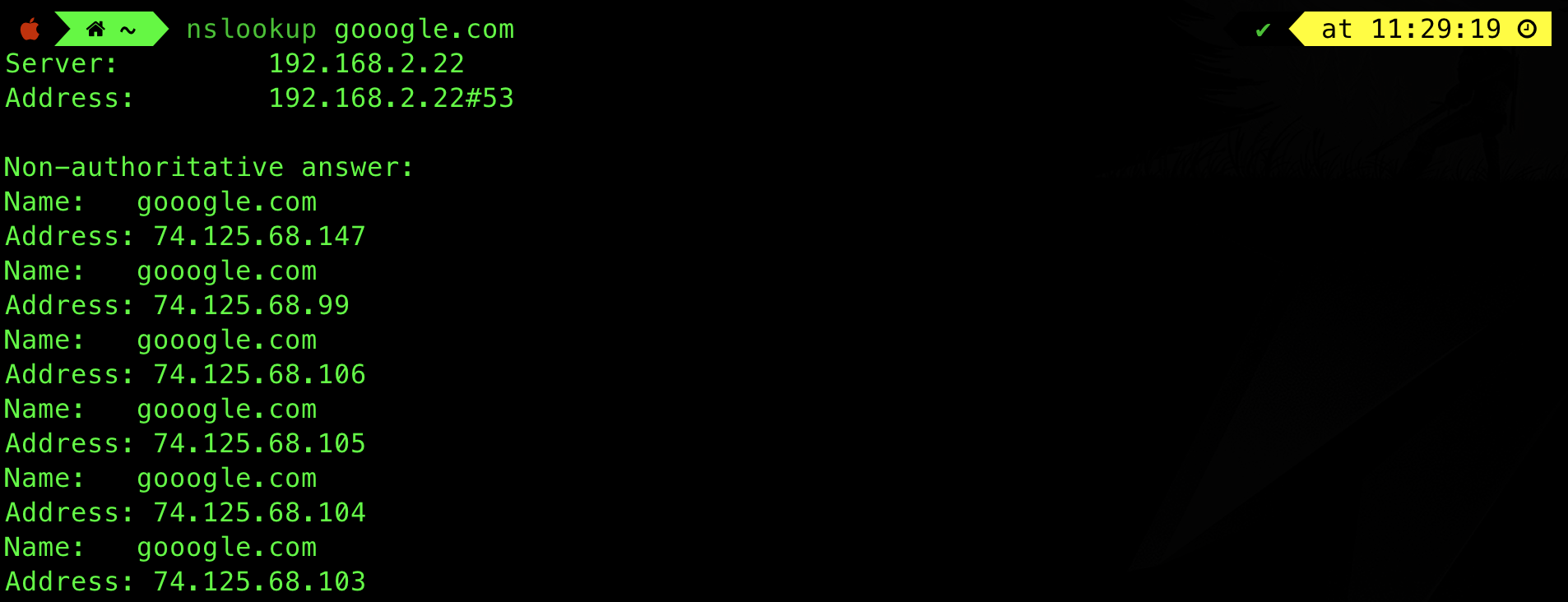
There are 6 different IP addresses for the same domain name: google.com. This one-to-many probably done by Google to ensure load balancing if there’s a surge of query made to access google.com website. We can ping one of them to check if they are alive:

The answer we obtain is non-authoritative because these records are obtained from the local name server instead: 192.168.2.22 (cached).
Obtaining authoritative answer
How do we find the IP translation from google.com’s authoritative name server? First, we need to find the NS-type record of google.com using nslookup:
nslookup -type=ns google.com

There are four NS-type records, which means that all these servers are the authoritative name servers for google.com. What we have to do now is to query one of them instead about the IP address of google.com:
nslookup google.com ns1.google.com
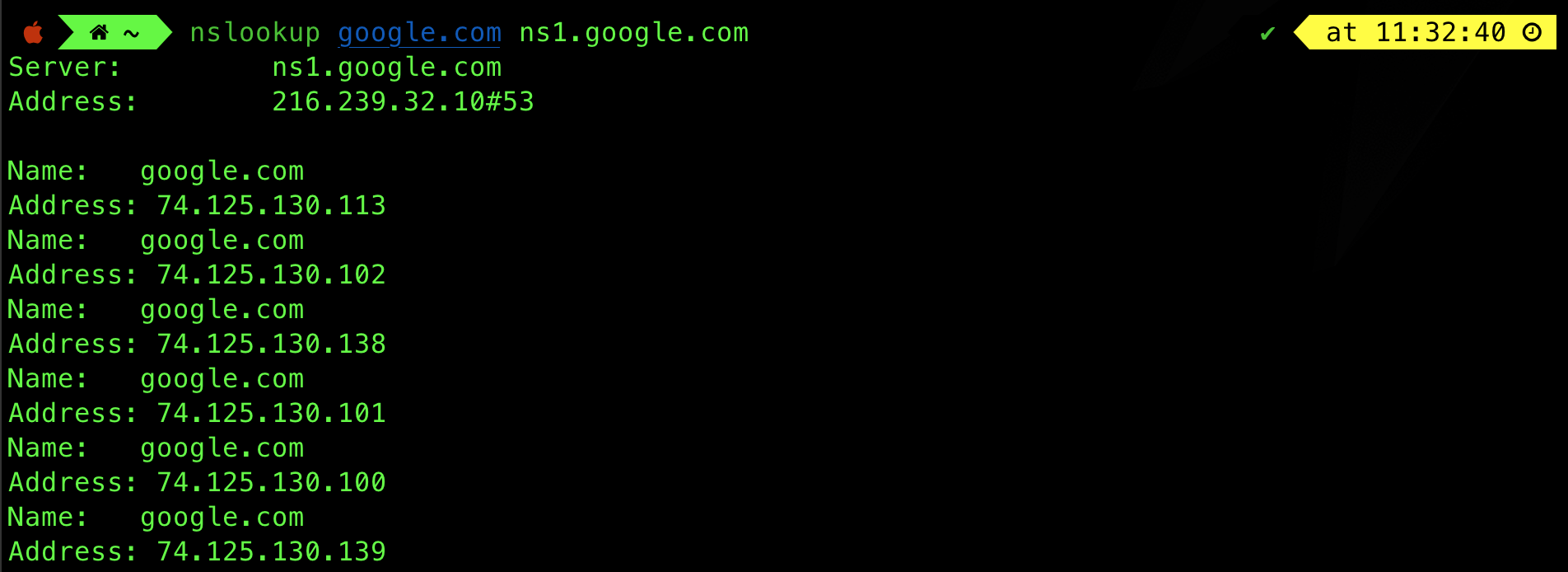
Notice that we have two names as arguments to nslookup. nslookup has to resolve ns1.google.com first (obtain its IP address), and then resolve google.com by sending a DNS query to ns1.google.com.
You can also do this manually:
- Resolve IP address of
ns1.google.com - Use that IP address to query about
google.com

You can also obtain the MX record type to obtain the names of the mail servers in google.com domain:
nslookup google.com 216.239.32.10 -type=MX
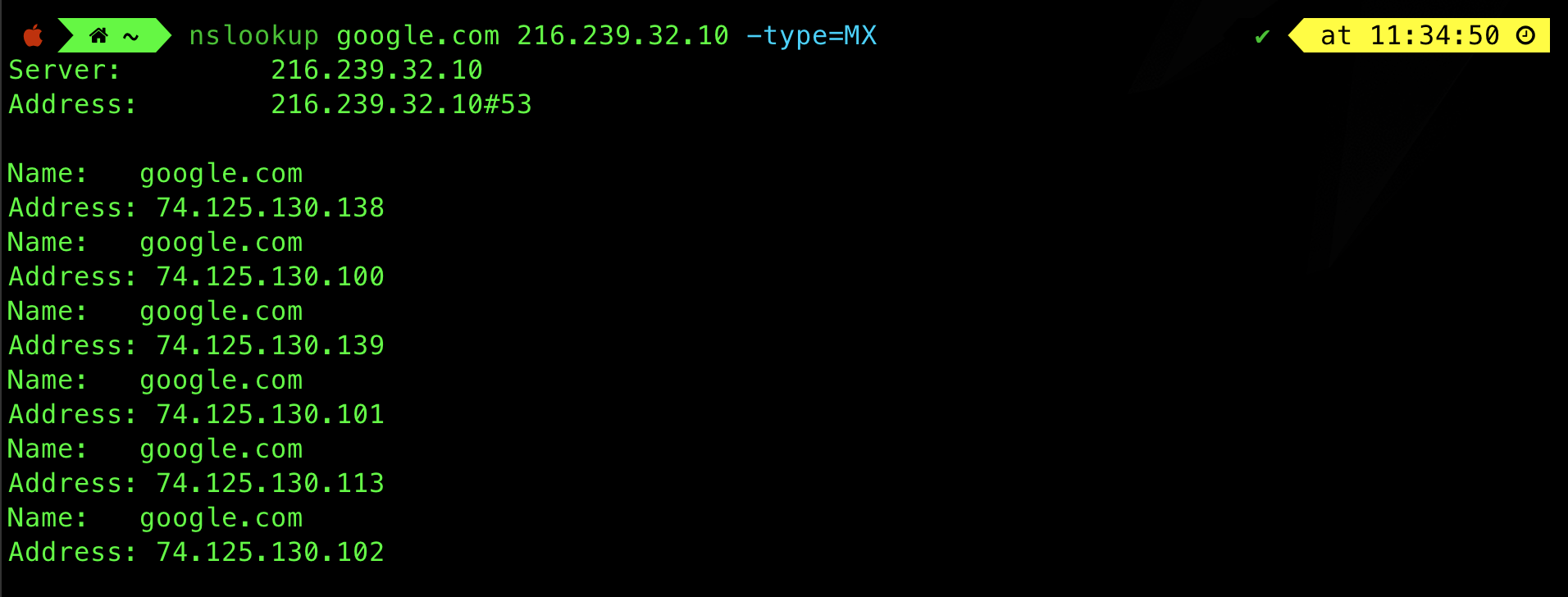
In nslookup, the absence of the “Non-authoritative answer” message typically indicates that the response is authoritative.
Example of DNS query via dig
We can also use another tool: dig (Domain information groper) to query the IP address for google.com:
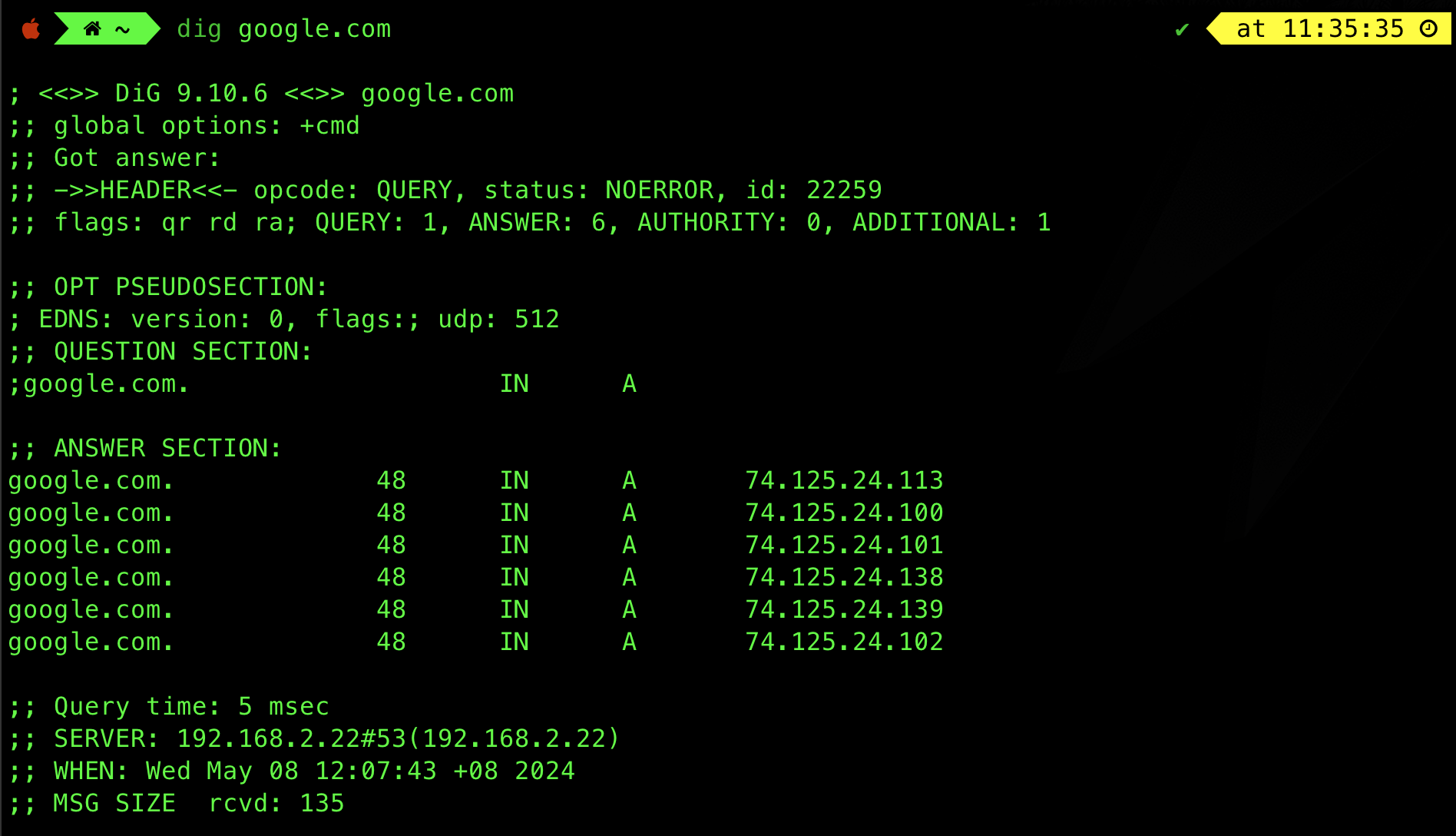
The output is a little different because dig decodes the DNS response and presents it in another format to us, but there’s some things we can relate to, and compare with the simplified DNS query and reply protocol we learned above.
-
Look at the header: we have id (transaction id) 22259.
- The flags section gives us more information about the response.
qr(query response): indicates that the message was a response, not a query. dig always renders out the DNS response, not queries, soqrflat will always be present.rd(recursion desired): Most of the timerdflag is set in the query so that we don’t have to iteratively resolve our query and avoid the manual workaa(authoritative answer): if present, the response is obtained from an authoritative nameserver. In this example, there’s noaaflag so our answer is not obtained from the authoritative nameserver ofgoogle.comra(recursion available): this flag indicates that recursion was available from the remote name server.
- Next we have numbers of queries, answers, authority and additional section.
- The authority section typically indicates the server(s) that are authoritative for answering DNS queries about that domain. In this example, we don’t have any answer in the authority section.
- The other sections are self explanatory
- Next is the answer section, we have 6 A records for
google.com.- In
dig, we know that this is non-authoritative because otherwise there’s supposed to be anaaflag set (indicating authoritative answer). * Therefore, this answer comes from the local nameserver’s cache. - Each column in the ANSWER section indicates: TTL, CLASS, TYPE, and VALUE.
- 48 means TTL in seconds, and IN stands for INTERNET.
- In
At the bottom of the screenshot, the SERVER means our local DNS server making the query for us. Our local DNS server has an IP of 192.168.2.22. The transport layer protocol utilised by DNS is UDP and the port used is #53. We will learn more about UDP and TCL in the next chapter.
Obtaining authoritative answer
Suppose we want to obtain an authoriative answer to resolve google.com using dig, we can query one of its authoritative nameservers like before instead:
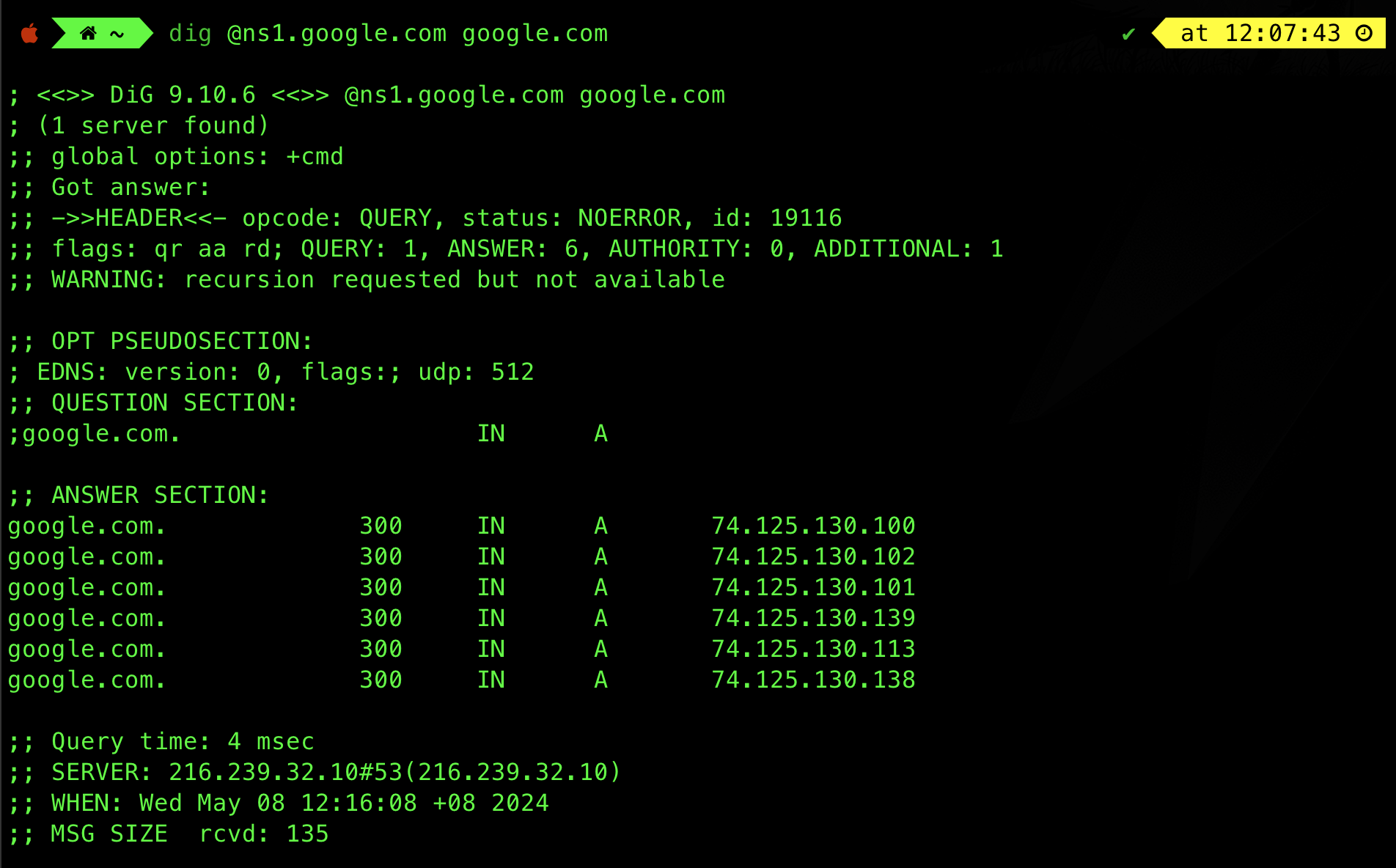
- This response contains an authoritative answer, with the
aaflag set. - There’s no
raflag because this nameserver has recursion disabled, probably for security reasons.
DNS Caching
The Local Name Servers will cache hostname-ip mapping once a query is made for a certain TTL (time to live). Due to this caching mechanism, TLD servers are typically cached in DNS local name servers, allowing for faster resolution. On the other hand, Root servers are often not visited.
Handling Cache Update
Cached entries may be out of date, e.g: if a host changes IP address, it may not be known Internet-wide until all TTLs (time-to-live) expire.
- The authoritative name server decides the DNS record TTL, for example, Netflix’s authoritative name server decides the TTL for its DNS records
- The local nameserver re-queries when TTL expires
- The update or notify mechanisms of these caches are proposed by IETF standard, in particular, RFC 2136 – Dynamic Updates in the Domain Name System (DNS UPDATE)
Inspecting cached queries
Try running dig [SOME-DOMAIN] twice or thrice, and see if the subsequent query is faster. That means your subsequent query (not the first one) is cached, while the first one is not.
# run this twice, consecutively
dig nus.edu.sg
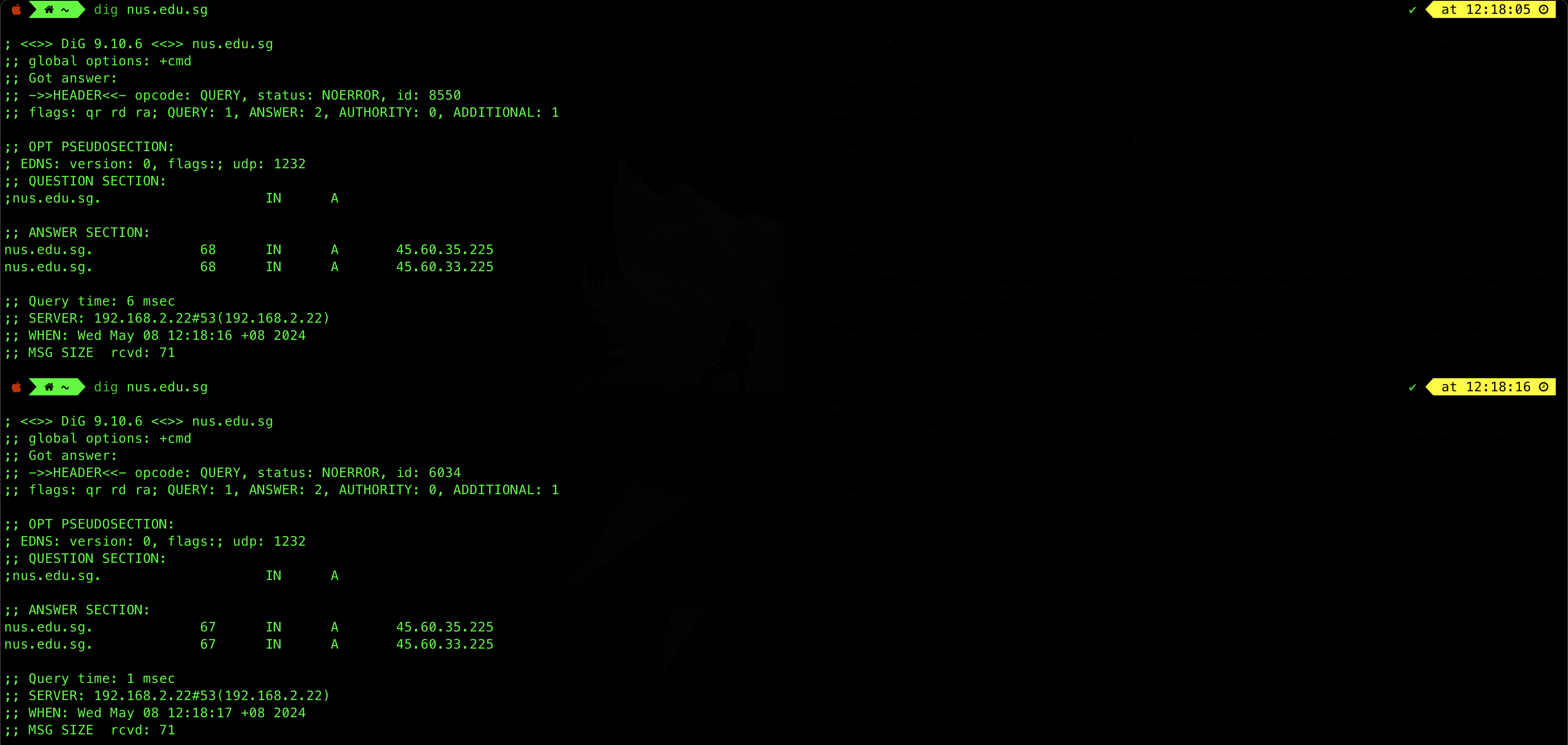
In the example above, the second query about nus.edu.sg is faster (just 1ms) compared to the first query.
Alternatively, you may disable recursion, for instance:
dig google.com +norecurs
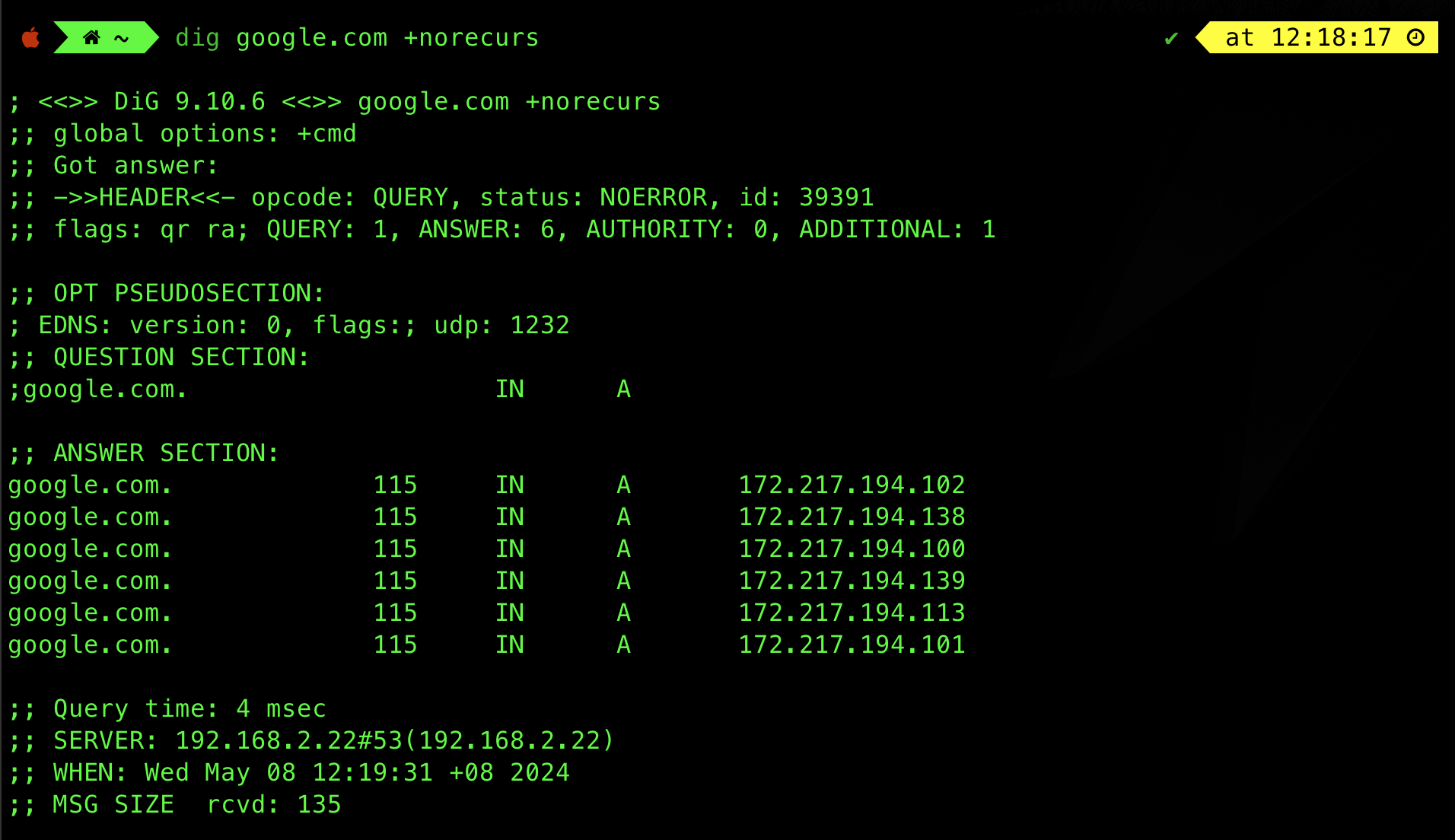
If you still have an answer like the above, then the answer was from cache.
Try some website you rarely visited, e.g:
dig selfridges.com +norecurs
This time round there’s no answer provided, meaning that this record was not cached:
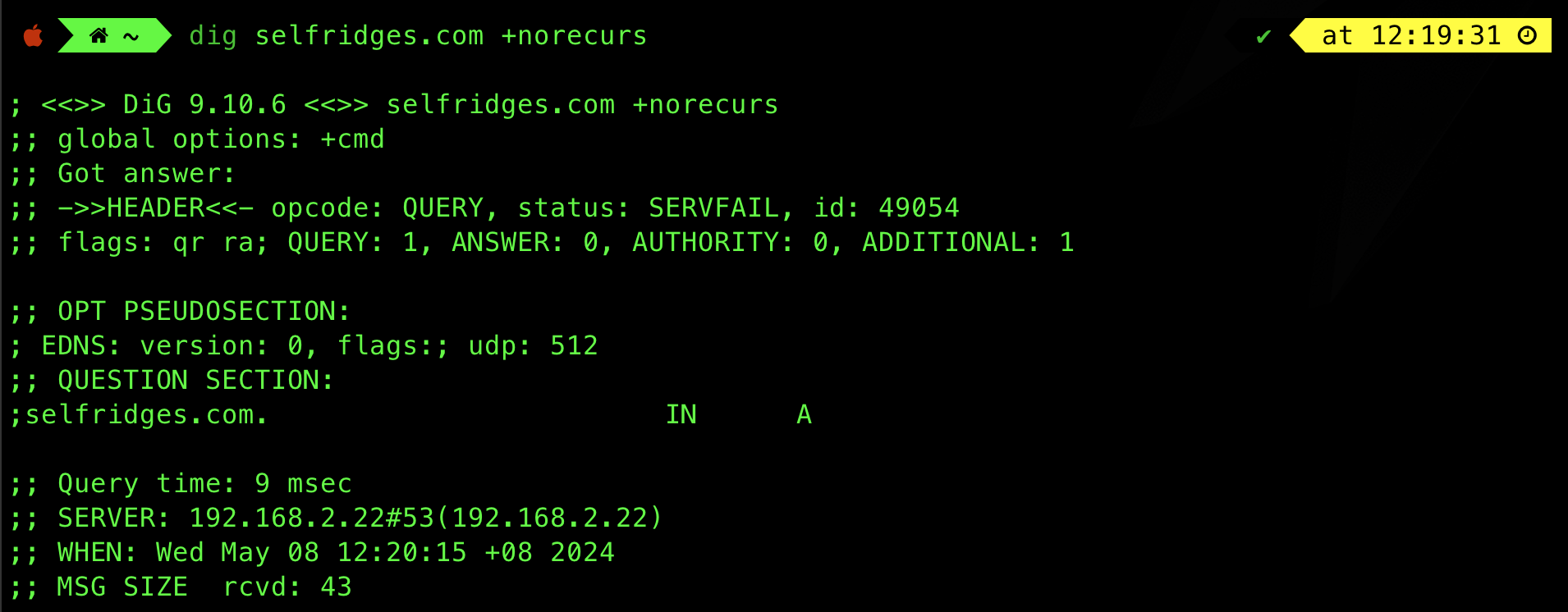
DNS Record Insertion
DNS Record Insertion
DNS record insertion refers to the process of adding new records to a DNS zone to manage the resolution of domain names into IP addresses or other information. For example, if you manage your own DNS server at home (authoritative to sites you host at home), then you will need to insert some record (information about your authoritative DNS server at home) to the TLD.
Even though you manage your own DNS zone, it is still part of a larger DNS hierarchy.
Suppose you want your website to be accessible via the internet using your own domain name. You can insert (or register) DNS records to ensure that they are recognized Internet-wide, allowing other hosts to find your website. The steps are as follows:
- Find a DNS Registrar to register the domain name of your site
- Find authoritative nameservers that will be responsible for solving your domain name
- Insert DNS records (A type) into the authoritative nameservers
- Insert DNS records (NS types) of your authoritative nameservers to the TLD
DNS Registrar
A DNS registrar, also known simply as a domain registrar, is a company or organization accredited to manage the reservation of domain names on the internet.
Example registrar: Amazon Domain Registrar, GoDaddy. GoDaddy and AWS Route 53 allows you to register new domain names. You can search for and purchase domain names directly through GoDaddy website or the AWS Route 53 console.’
Note that a registrar is not a registry (see appendix for definition of registry). A Registrar interfaces with the general public regarding the registration of their domain names. In short, they sell domain names. See more examples of registrars here.
Therefore, suppose for you want your website to be reachable at examplesite.com. You then need to buy this particular domain name (if it is still available) from any of the registrars above.
Authoritative Name Servers
You will then need to provide the names and IP addresses of the authoritative name server (primary and secondary server as backup) responsible for resolving this domain name examplesite.com.
Authoritative name servers can be maintained by you (if you know how to manage a DNS server), or an ISP or other related companies (DNS hosting providers). For example, SUTD has 3 Authoritative nameservers hosted by starhub, and also SUTD herself.
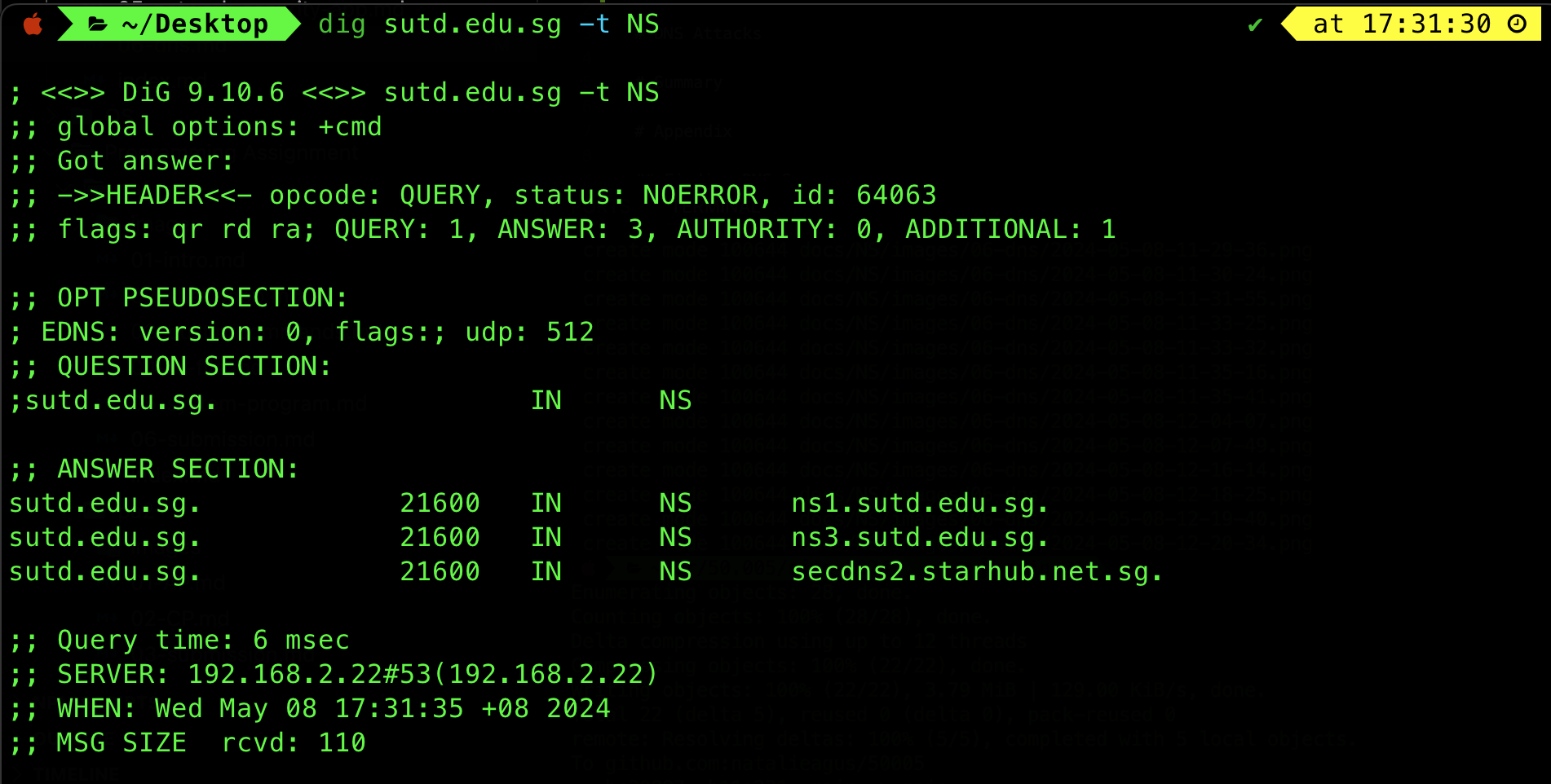
You can engage services like AWS Route 53 to be your domain’s authoritative nameservers. You will need at least two authoritative name servers. For instance, suppose AWS Route 53 assign you the following authoritative nameservers:
- ns-1312.awsdns-36.org: 20.50.23.12
- ns-788.awsdns-34.net: 53.25.22.11
This means that you shall insert the A record of your domain examplesite.com into both of these authoritative nameservers. Suppose your website is hosted at IP address: 111.222.111.222, then:
- Insert A record:
examplesite.com, 111.222.111.222, A, TTLinto ns-1312.awsdns-36.org DNS server - Insert the same A record into ns-788.awsdns-34.net DNS Server
You can also insert MX record type to both authoritative name server if your organization also has a mail server, e.g: suppose you rely on Microsoft’s email services, you shall insert MX record: examplesite.com, example.mail.protection.outlook.com, MX, TTL.
TLD Update
Since you rely on AWS Route 53 for your authoritative nameservers, then Amazon is responsible for inserting the NS records for examplesite.com into the appropriate TLD server (.com TLD server in this example). These NS records are useful to indicate the Authoritative Name Server responsible for your domain:
examplesite.com,ns-1312.awsdns-36.org, NS, TTLexamplesite.com,ns-788.awsdns-34.net, NS, TTL
The A record for these two nameservers must also be present and reachable from the internet. For instance, The IP addresses of ns-1312.awsdns-36.org and ns-788.awsdns-34.net are registered within the respective TLDs (.org and .net). This means that the .org and .net registries contain the A records for these nameservers. For example:
ns-1312.awsdns-36.org,20.50.23.12, A, TTLns-788.awsdns-34.net,53.25.22.11, A, TTL
If the authoritative nameserver happen to be in the .com domain, then the .com TLD should contain glue records to avoid circular dependency. Head to appendix if you’d like to find out more.
DNS Attack
Since DNS is a crucial part of the internet, it is prone to various attacks. Example of some DNS attacks are as follows:
- DDoS attack (Denial of Service): done either by bombarding root servers with traffic or bombarding TLD servers with traffic. The latter is potentially more dangerous since they are cached by local DNS servers.
- Root server bombarding is not successful to date due to traffic filtering and that local DNS servers cache IPs of TLD servers, hence we typically bypass the root servers
- Redirect attack (Man in the Middle): done via DNS Cache Poisoning, which is to send bogus replies to local DNS server, which caches the replies
- Intercept DNS queries, direct it to a bogus server (not the actual server)
- Client wont’t be able to reach the actual server
- Exploit DNS for DDoS:
- Send queries with spoofed source address (that’s our target victim IP)
- Amplify these queries
- DNS servers that receive queries will answer to our target victim IP and flood it, causing its domain to be inaccessible
Summary
DNS resource records (RRs) are crucial for translating domain names into IP addresses and providing essential information about domains. Key types include A (maps hostnames to IP addresses), NS (specifies authoritative nameservers), CNAME (maps aliases to canonical hostnames), and MX (points to mail servers).
The DNS query process starts with the local nameserver and may involve querying authoritative nameservers if the local server lacks the information. DNS caching enhances query speed by storing records for a set TTL, though it can lead to outdated information. DNS record insertion involves registering a domain, designating authoritative nameservers, and updating records in these servers and the TLD. DNS protocols are susceptible to attacks such as DDoS, DNS cache poisoning, and amplification attacks, which can disrupt or exploit the DNS infrastructure.
Tools like dig and nslookup aid in crafting and interpreting DNS queries and responses.
Appendix
Start of Authority
The SOA (Start of Authority) record is a type of DNS (Domain Name System) record that contains administrative information about a DNS zone. It is one of the essential records in a DNS zone file, acting as a blueprint that provides details about the zone and how it should be managed. The SOA record is mandatory in every DNS zone and is used to convey properties about the zone to the DNS infrastructure.

When you use the dig command to query DNS and receive a reply containing just an “SOA” (Start of Authority) record, this provides crucial information about the DNS zone, but it might also indicate specific query contexts or configurations.
Understanding the SOA Record
The SOA record is one of the most important types of DNS records and appears at the beginning of a zone file. It contains administrative details about the zone, including:
- Primary DNS server - The authoritative name server for the domain.
- Responsible party - The email address of the person responsible for administering the domain’s DNS zone.
- Serial number - A sequence number that increments whenever the zone file is updated. This is used by secondary DNS servers to check if they need to update their copies.
- Refresh rate - How frequently secondary DNS servers should check if updates are needed.
- Retry rate - How long a secondary server should wait before retrying after a failed refresh.
- Expire time - How long the zone will be considered valid if the secondary server can’t reach the primary server.
- Negative caching TTL - Time to Live value for negative results, indicating how long a DNS resolver should cache the absence of a record.
Why You Might See Only an SOA Record
If your dig query returns only the SOA record, here are a few reasons why this might happen:
-
Query for Non-Existent Subdomain: If you query a subdomain or record that doesn’t exist, the DNS server might return the SOA record to indicate the authoritative server for that zone, especially if the query is for a non-existent type (e.g., asking for an MX record where none exists).
-
Zone Transfer Attempt: If you attempt a zone transfer (e.g., using
dig AXFR) and it’s not allowed by the server configuration, the server may return the SOA record as a part of its refusal to provide a zone transfer. -
Specific DNS Query: If your query explicitly asks for the SOA record (e.g.,
dig SOA example.com), then naturally, the SOA record will be the response. -
DNS Configuration Issues: Sometimes, misconfigurations in the DNS setup might lead to unexpected results like only returning an SOA record even if other records exist.
Example of a dig Command Showing an SOA Record
dig SOA google.com

This command will provide you with the SOA record for google.com, listing the details as explained above. If this wasn’t the intended result and you were expecting other types of DNS records, you might want to specify the record type directly in your dig query, such as A, MX, CNAME, etc., or check if the domain or subdomain queried is correctly configured in the DNS.
Domain vs Hostname
The terms “domain” and “hostname” can sometimes be used interchangeably, but they have specific meanings that are worth distinguishing, especially in the context of how a domain like sutd.edu.sg can also function as a hostname.
Domain
A domain is part of the Domain Name System (DNS) hierarchy. It is a subset of the broader internet address space that is reserved or registered under a specific name. For example, in sutd.edu.sg, edu.sg is the second-level domain (part of the .sg country code top-level domain), and sutd is a third-level domain under edu.sg.
Hostname
A hostname is a specific identifier used for a device or a node on a network. It is the label assigned to a device connected to a computer network and is used to distinguish one device from another on that network. Hostnames are part of fully qualified domain names (FQDNs), which provide specific addresses for individual nodes.
How Domains Can Also Be Hostnames
In many cases, especially with organizational or institutional websites, the domain name can also serve as the hostname. For instance, sutd.edu.sg can be set up to be both the domain name of the Singapore University of Technology and Design and the hostname for the main server where their primary website is hosted.
Example Breakdown
- Domain:
sutd.edu.sg - Hostname: In network terms, the hostname could simply be
sutd.edu.sgif that’s how the primary server is identified within the network. - FQDN: The FQDN might simply be
sutd.edu.sg, pointing directly to the server that hosts the university’s main website.
Practical Implementation
When you enter sutd.edu.sg in a web browser:
- DNS resolves
sutd.edu.sgas a hostname to an IP address where the server hosting the university’s main website can be reached. - Technically, the hostname can have prefixes like
www, sowww.sutd.edu.sgmight also point to the same server or to different services as needed.
Thus, while a domain is part of the DNS hierarchy and serves as a human-readable address for a section of the internet, a hostname is a specific address for a network node (often a server). A domain like sutd.edu.sg can serve as both, fulfilling the roles of domain and hostname, especially if it directly points to a specific server hosting services under that domain.
Registry
A Registry only interfaces with the Registrar and is responsible for delegating IP addresses and the DNS infrastructure. A registry manages top-level domain (TLD) names, meaning it maintains an authoritative database regarding top level domains including zone files. They create domain name extensions (see here, there’s many domain name extensions out there, not just .com), set the rules for that domain name, and work with registrars to sell domain names to the public.
Example: Verisign, Comcast, etc. They are all accredited by ICANN. See more examples here.
Glue Records
A glue record is an A (IPv4) or AAAA (IPv6) record that provides the IP address of a nameserver. Glue records are used to prevent circular dependencies and ensure that DNS resolvers can find the nameserver’s IP address. They are necessary when the nameserver’s domain is the same as, or a subdomain of, the domain it serves.
Example of a Glue Record
Consider the domain examplesite.com with nameservers ns1.examplesite.com and ns2.examplesite.com. Without glue records, there would be a circular dependency:
- To resolve
examplesite.com, the DNS resolver needs to contactns1.examplesite.com. - To resolve
ns1.examplesite.com, the DNS resolver needs to contactexamplesite.com.
This creates a situation where the resolver cannot find the IP address of the nameserver without already knowing the IP address.
How Glue Records Work
Glue records are provided by the parent zone (in this case, the .com TLD) to break this circular dependency. Here’s how it works:
- Domain Registration: When you register
examplesite.com, you specifyns1.examplesite.comandns2.examplesite.comas nameservers. - Registrar Submission: Your registrar submits the NS records and the corresponding glue records to the
.comTLD.
NS Records:
examplesite.com. NS ns1.examplesite.com.
examplesite.com. NS ns2.examplesite.com.
Glue Records (A records for the nameservers):
ns1.examplesite.com. A 192.0.2.1
ns2.examplesite.com. A 198.51.100.1
These glue records are stored in the .com TLD zone file. When a resolver queries the .com TLD for examplesite.com, it receives the NS records along with the glue records:
Response from the .com TLD:
examplesite.com. NS ns1.examplesite.com.
examplesite.com. NS ns2.examplesite.com.
ns1.examplesite.com. A 192.0.2.1
ns2.examplesite.com. A 198.51.100.1
The resolver now knows the IP addresses of the nameservers and can contact them directly to resolve examplesite.com.
Conclusion
Glue records are essential for breaking circular dependencies when a nameserver’s domain is within the same zone it serves. They are provided by the parent zone to ensure that DNS resolvers can find the IP addresses of the nameservers.
Visual Representation
Here’s a step-by-step visual of the process:
- Querying for
examplesite.com:- Resolver queries
.comTLD forexamplesite.com. .comTLD responds with NS records and glue records.
- Resolver queries
- Contacting Nameservers:
- Resolver now has IP addresses for
ns1.examplesite.comandns2.examplesite.comfrom the glue records. - Resolver contacts
ns1.examplesite.comorns2.examplesite.comdirectly to resolveexamplesite.com.
- Resolver now has IP addresses for
This ensures that the nameservers are reachable, and the DNS resolution process can proceed smoothly.
 50.005 CSE
50.005 CSE